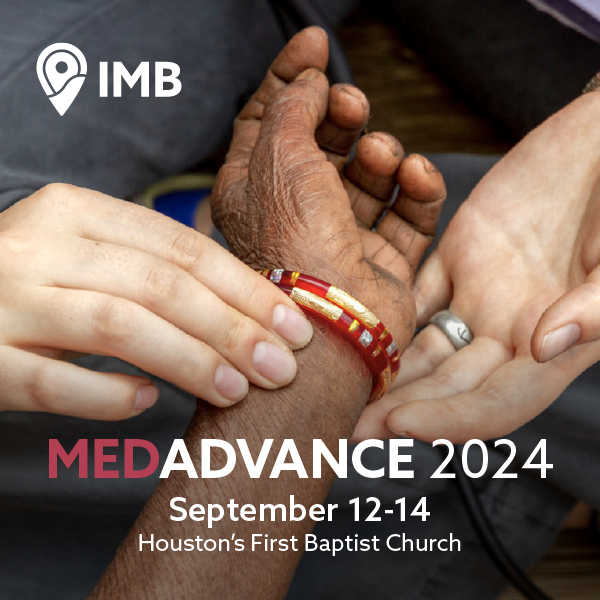
NASHVILLE, Tenn. (BP)–“The Da Vinci Code” sounded a battle cry, and evangelicals have responded by taking up their pens to combat a challenge to some of the most central doctrines of the Christian faith.
“The Da Vinci Code,” a movie from Sony Pictures set to debut in theaters May 19, is based on a bestselling novel by Dan Brown and attacks such key doctrines as the deity of Christ, the reliability of the gospels and the bodily resurrection of Jesus. The movie also claims that Jesus was married to Mary Magdalene and had a child whose descendents are still alive.
Erwin Lutzer, senior pastor of The Moody Church in Chicago; Darrell Bock, research professor of New Testament studies at Dallas Theological Seminary in Dallas, Texas; and R. Albert Mohler Jr., president of Southern Baptist Theological Seminary in Louisville, Ky., are among the many evangelicals who have refuted the movie’s claims.
“[T]his is not merely any piece of fiction. The scope of what it claims as fact, the impression it leaves making those claims under the ‘cover’ of fiction, and the fact that it addresses a significant subject for our culture’s own self understanding make it important that its claims be assessed and/or appreciated,” Bock writes in his book “Breaking the Da Vinci Code.”
He continues, “[T]he issues of faith and relationship to God are too important to be left to the confusing category of ‘historical’ fiction where the claim is that despite being a novel the history is fact.”
Brown’s novel opens with the curator of the Louvre Museum found murdered. Paris police call Harvard professor Robert Langdon and cryptologist Sophie Neveu to interpret a strange symbol left on the victim’s body. As they investigate, Langdon and Neveu realize that the crime is linked to the legendary search for the Holy Grail.
When Neveu warns Langdon that he is the prime suspect in the murder investigation, the pair flees from police as they simultaneously attempt to crack the case.
Langdon and Neveu meet Holy Grail fanatic Sir Leigh Teabing, who tells them about an understanding of Jesus different from the New Testament’s account. He says that the Holy Grail — rather than being a cup, as traditionally thought — is actually the remains of Jesus’ wife who bore His child.
Despite what everyone has been taught, Teabing says, Jesus was married to Mary Magdalene and had a daughter. After Jesus’ crucifixion, Mary and her daughter went to France where they established the Merovingian line of French royalty. This dynasty, according to “The Da Vinci Code,” continues today in a mysterious organization known as the Priory of Sion. Members of the Priory of Sion supposedly included Leonardo da Vinci, Isaac Newton and Victor Hugo.
Teabing and Langdon tell Neveu that the records of the true story of Jesus are guarded and shrouded in mystery. The real story about Mary and Jesus, they say, has been preserved in hidden codes and symbols in order to avoid the wrath of the Catholic Church.
Leonardo da Vinci knew the real story about Jesus, we are told, and used his painting “The Last Supper” to give hidden clues.
As the main characters continue their investigation, they learn that a powerful Catholic organization called Opus Dei is prepared to use any means necessary to keep the true story of Jesus from coming out. If the secrets are revealed, we are told, Christianity, as we know it, will be exposed as a fraud built on centuries of lies.
The movie advocates a false picture of Christianity, but believers can refute the errors by noting the biblical picture of Jesus and the true history of the faith, according to Lutzer, Bock and Mohler.
Following are some of the major heresies of “The Da Vinci Code”:
— Error: The Council of Nicea invented the deity of Christ in A.D. 325.
“The Da Vinci Code” argues that for the first 300 years after Christ, Jesus’ followers viewed Him as a mere human. Then the Council of Nicea invented the deity of Christ for political purposes.
Mohler says the Council of Nicea did not invent the deity of Christ but proclaimed what the Bible taught and what the church had believed for 300 years.
“The Council of Nicea did not ‘invent’ the divinity of Jesus,” Mohler writes in an Internet commentary. “This was already the declaration of the Church, claimed by Jesus himself and proclaimed by the apostles.”
The Roman Emperor Constantine called the Council of Nicea so that the bishops of his empire could settle disputes about Christ’s nature. The disputes centered on a man named Arius who gained a wide following by teaching that Jesus was a created being and not fully God. Orthodox Christians opposed Arius.
After discussion, the bishops at Nicea issued a creed affirming Scripture and declaring Jesus to be of the same nature as the Father and Arius a heretic. Only two bishops out of more than 300 present did not sign the creed.
In response to the question of whether Nicea invented the deity of Christ, Lutzer writes, “There is not a single shred of historical evidence for such a notion. Not only was Christ’s deity the consensus of the delegates, but as can easily be shown, this doctrine was held by the church centuries before the council met.”
— Error: Other gospels were banned from the Bible by people who wanted to make the church a patriarchal community.
In what Bock calls perhaps “the most misleading statement of ‘fact’ in the entire novel,” Brown claims there were more than 80 gospels considered for the New Testament but that only four were chosen. The “banned” books were suppressed because they showed the truth about Jesus and allowed women to take leadership in the church, according to “The Da Vinci Code.”
Although there were not 80 of them, “The Da Vinci Code” refers to what are called the Gnostic gospels, Bock says. These writings advocated an unbiblical understanding of Jesus’ life and ministry that the church rejected as heresy beginning during the time of the apostles.
According to Bock, the Gnostic gospels taught that some Christians had secret knowledge not available to all; that there is one spiritual, transcendent God and one physical, wicked Demiurge who created the physical world; and that Jesus did not actually suffer on the cross. The Gnostic gospels also allow women to experience secret revelation and be leaders in the church, Bock says.
But the church never even considered including the Gnostic gospels in the Bible, Lutzer said.
“To put it mildly, there is no reason to accept the Gnostic gospels as historically worthy; their value lies in telling us what the Gnostics believed, even though the writings shed no now new light on Jesus, Mary Magdalene, or early Christianity,” Lutzer writes.
The 27 books of the New Testament were affirmed by Christians as Scripture based primarily on their ties to an apostle, as well as their impact on the church and their internal qualities.
— Error: Jesus was married to Mary Magdalene.
In his novel, Brown claims that “the marriage of Jesus and Mary Magdalene is part of the historical record.”
But Bock and Lutzer point out that the Scripture and other historical documents give no reason to believe Jesus was married.
Scripture says that Mary was a disciple of Jesus out of whom Jesus cast a demon, that she was present at the cross and that she was a witness to the resurrection, according to Bock. The early church fathers also refer to Mary as “a faithful disciple, a follower of Jesus who witnessed Jesus’ death, burial, and resurrection,” Bock says, noting that Scripture never indicates that Jesus and Mary were married.
Two Gnostic gospels mention Mary’s relationship with Jesus, Lutzer writes. “The gospel of Philip,” written in the fourth century, says Jesus “loved” Mary “more than his students” and kissed her often. But the poor quality of the manuscript prevents scholars from reading where Jesus supposedly kissed Mary.
Lutzer observes that the text might have said “the hand” or “the cheek” and is not an accurate account anyway.
The Gnostic “gospel of Mary” says Mary had a special relationship with Jesus and a rivalry with Peter. Lutzer notes, “Even if these accounts from the Gnostic Gospels were accurate, it is a stretch to say that Mary had a romantic relationship with Jesus, much less that she was married to him.”
Bock notes additional evidences that Jesus was single. If Jesus was married, Paul likely would have referred to Jesus in 1 Corinthians 9 in defense of a minister’s right to marry, he writes. Jesus also showed no special concern for Mary while He hung on the cross — an act that we would expect from a husband.
— Error: There is no agreed-upon and authoritative version of the Bible.
“The Bible did not fall magically from the clouds,” says Teabing in “The Da Vinci Code.” “Man created it as a historical record of tumultuous times, and it has evolved through countless translations, additions, and revisions. History has never had a definitive version of the book.”
Lutzer explains that there were books — in addition to the Gnostic gospels — written around the time of the New Testament books that were excluded from the canon, but the teaching of these books was sometimes vastly different from the New Testament Gospels. For example, one book claims that when Jesus was a child, he killed another child by pushing him off a room and when accused, responded by raising the boy from the dead.
The Old Testament books were gathered by the nation of Israel as God gave authoritative revelation over the centuries, Lutzer writes. The last book of the Old Testament — Malachi — was completed around 400 B.C. Christians’ confidence in the authority of the Old Testament books comes from the fact that they were accepted by the Jews and by Jesus.
The New Testament books were written in the first century, but “because of limitations of communication and travel, some time passed before the number of books regarded as authoritative was finally settled,” Lutzer writes.
By the end of the first century more than two thirds of the present New Testament was viewed as inspired, and the remaining books were known and quoted as authoritative.
A mutilated fragment from A.D. 175 lists books that were accepted as canonical by that time and contains 23 of the 27 New Testament books. The books that Christians today recognize as the New Testament first appeared together on a printed list in A.D. 367 but were recognized as the authoritative rule of the church for more than 250 years prior to that date.
“The Da Vinci Code” also argues that the Council of Nicea decided on the books of the New Testament. Mohler said that is not true.
“The early church did not establish the canon … at Nicea, though general consensus was already evident at that gathering. The New Testament writings were recognized and set apart because of their authorship by one of the apostles and by their clearly orthodox content — in harmony with the other New Testament writings as recognized by the churches spread throughout the Greco-Roman world.”
–30–
“Da Vinci Code” resources are available at LifeWay Christian Stores and online at www.LifeWayStores.com















